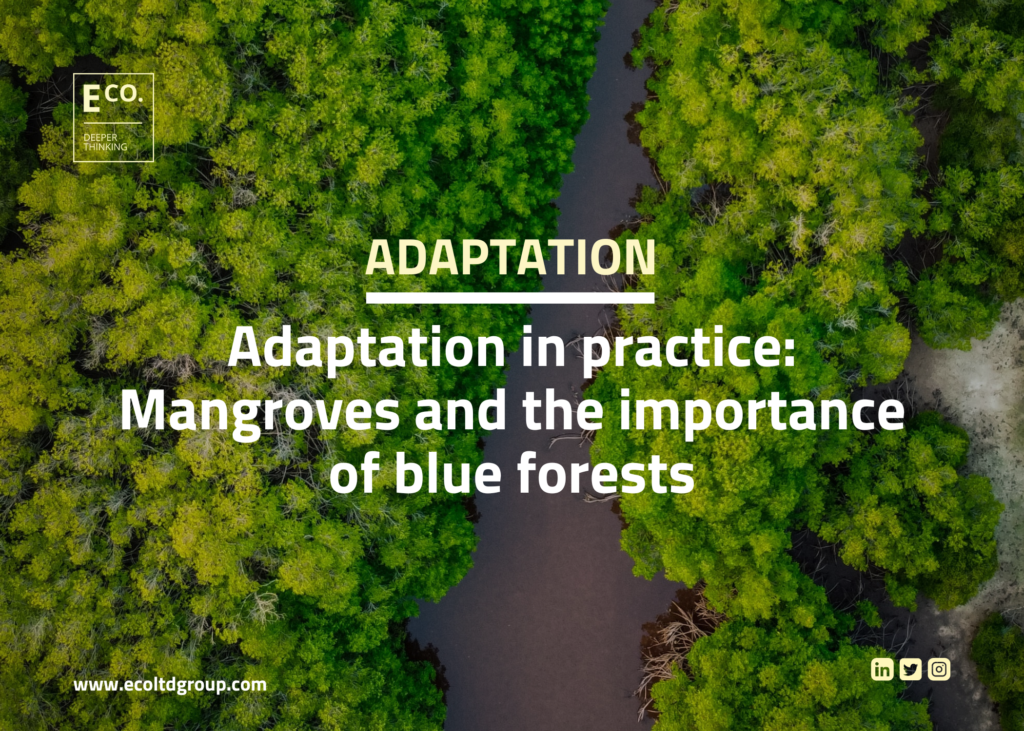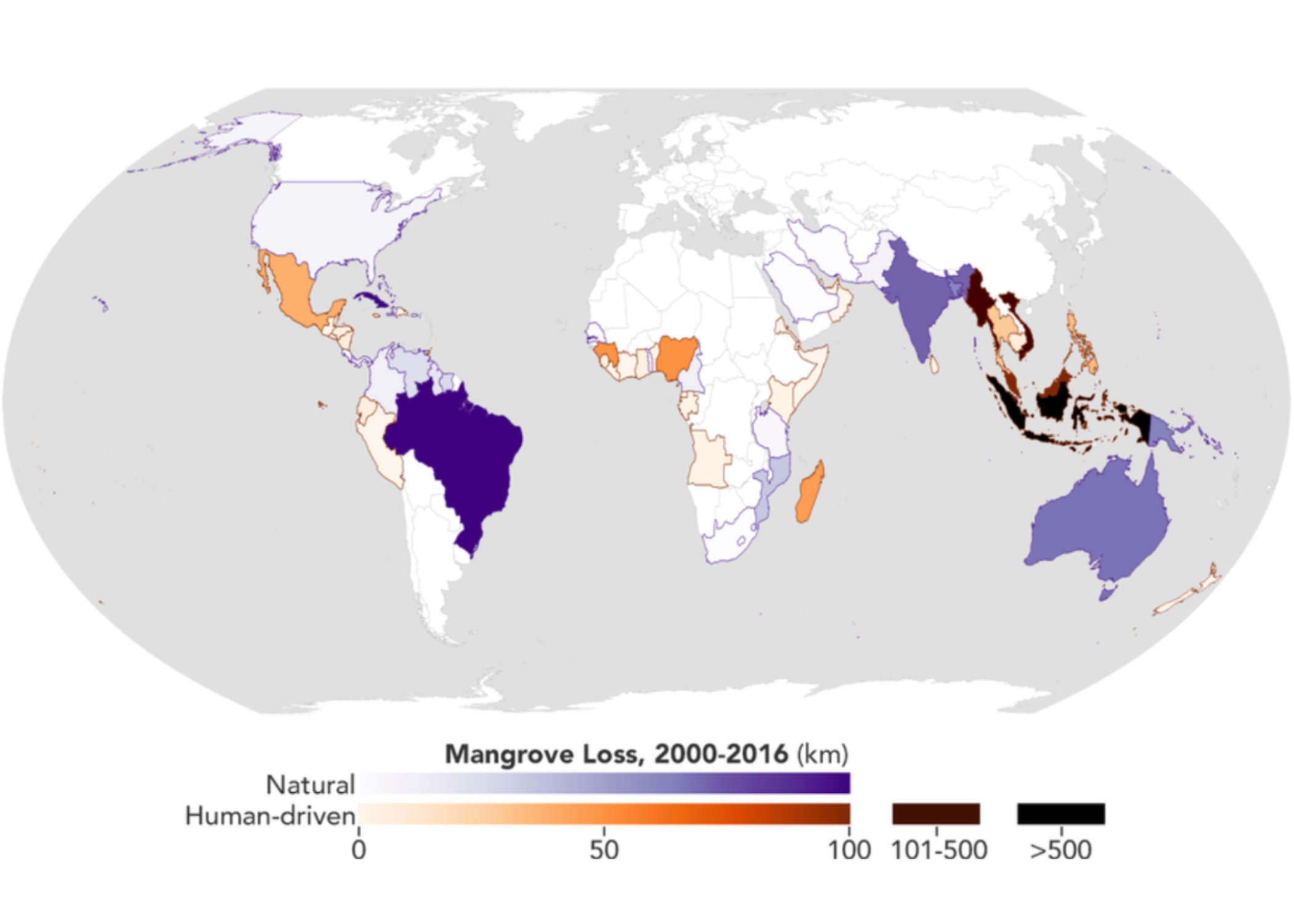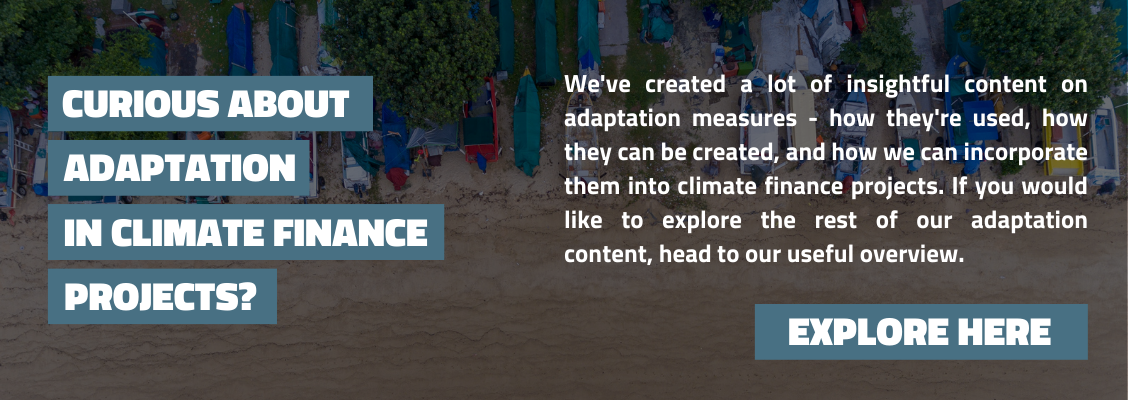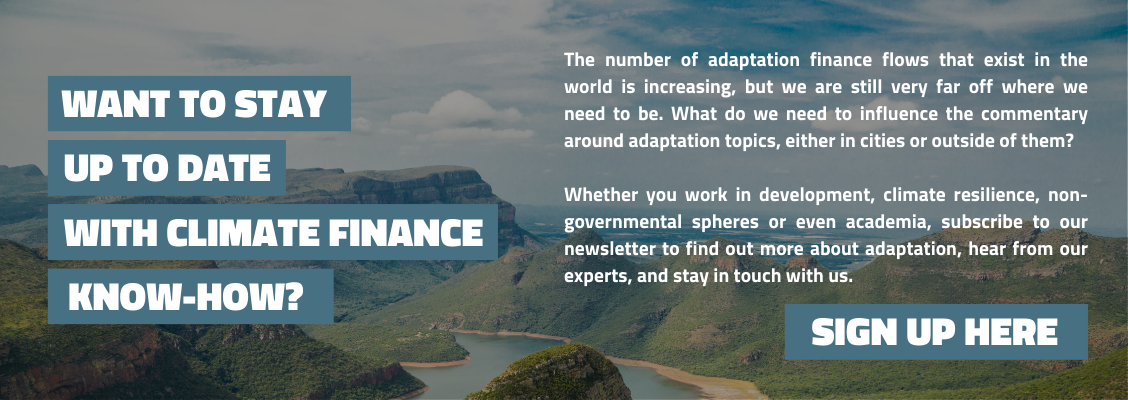Adaptation in practice: Mangroves and the importance of blue forests
23 June 2023, Category: All insights, News, Tags: adaptation, blue forest, climate change, climate finance, mangrove, mangrove forest

Blue forests are incredibly important ecosystems, and if there is one type of blue forest ecosystem that needs increased support and protection, it is mangrove forests. Mangroves, a species of salt-tolerant trees and shrubs that thrive in intertidal zones, cover 147,000km2 of land globally – an area equivalent to the size of Bangladesh. These areas are some of the most vulnerable ecosystems on the planet, suffering from a myriad of issues, from human-led deforestation to coastal erosion [1].
The total losses caused by these issues are difficult to calculate, however it is estimated that over the last 50 years, 20-35% of total mangrove coverage has been lost [2]. The rate of loss is not linear across countries. For example, Thailand has lost 56% of its mangrove forests between the years 1961 and 1996, mainly due to the conversion of land for shrimp and salt farming [3].
Figure 1. The location and severity of mangrove habitat loss from 2000 to 2016.
In terms of their value as either a mitigation or adaptation measure, they are a proverbial jack-of-all-trades. Not only do they sequester carbon, they also aid in the protection of coastal areas, working to lessen the impacts of erosion and storms. Another benefit is their importance as biodiversity hotspots.
Mangroves also represent a brilliant opportunity for developing blue economy-focused areas, where resources can be used to aid the economic growth and improved livelihoods of local communities. So how can this be achieved?
- By recognising the importance of the ecosystem services that mangroves provide;
- By ensuring that blue forests and the resultant services are utilised adequately within climate policy and climate finance project design;
- Through the development of fit-for-purpose climate finance projects and programmes that support mangrove restoration and reforestation.
What are blue forests and why are they important?
Blue forests are exactly that – forests which are situated and thrive either in, or under, the water. Kelp forests, rockweed forests, salt marshes, and seagrass meadows, are all examples of a blue forest. One of the most interesting is the mangrove forest. Mangroves, and other blue forests, are vital for protecting marine biodiversity and supporting the livelihoods of coastal and island communities – as well as providing many other ecosystem services.
One of the most important services they provide is their ability to sequester carbon. In marine and coastal ecosystems, this is referred to as ‘blue carbon’. This is just one of the processes that work together to provide contextual ecosystem services. For example, mangroves provide [4]:
- Provisioning services: The process of providing products such as food and timber;
- Cultural services: Non-material benefits gained from mangroves, such as spiritual or recreational value;
- Regulating services: Mangroves deliver such processes as carbon sequestration, flood control, and water purification;
- Supporting services: These are primarily services necessary for the delivery of all other ecosystem services – base natural processes such as nutrient cycling and photosynthesis.
Mangroves are one of the key engineers of the ecosystems they inhabit. Not only are they a keystone species, they also provide habitats for a wide range of organisms that require solid substratum (in an otherwise soft-sediment environment), such as barnacles, oysters, sponges, and algae. By slowing currents and reducing waves, the aboveground roots and trunks release the stress and disturbance from both epibiotic and benthic fauna. They also provide shelter and feeding grounds for fish and shrimp.
The importance of mangroves for livelihoods and local economies
Mangroves are an interesting and unique case study for the blue economy. While they represent a very small part of marine and coastal environments, their potential for the aid of local communities is vast.
Currently, mangroves are utilised for a variety of purposes. For example, in Bangladesh and Vietnam, the production of mangrove honey is a vital economic activity for local communities [5]. However, in Bangladesh this has been approached unsustainably due to a rise in unemployment, increasing the amount of honey collectors who do not know how to harvest in a sustainable manner.
Mangroves also represent avenues for new economic development, skill sharing, and training. For example, a GCF-UNDP project was recently initiated to introduce mangrove farmers in northern Vietnam to beekeeping, allowing them to diversify their income alongside supporting biodiversity and pollinators [6].
Coastal communities that lie near or within mangroves rely on them for subsistence foods such as fish, oysters, crabs, and other seafood. The Nipa palm (or mangrove palm), common to mangroves in the Indian and Pacific Ocean, produces edible fruit and is also tapped for both sugar and vinegar production [7]. A 2022 analysis by the World Bank found that the average monetary yield of every hectare of mangrove forest was USD 15,000 per year [8].
We must also discuss the important regulating services provided by mangroves. These services contribute to the overall balance of an ecosystem, aiding the functionality of the countless processes that make the ecosystem valuable for life and human livelihoods.
For example, in a carbon-accounting context, mangroves support a very high carbon sequestration rate, equivalent to that of tropical humid forests. They account for 14% of carbon sequestration in areas by the global ocean, and can contain an average of 937 tC ha-1 [9]. This is further aided by the type of environment mangroves thrive in, with the low-oxygen sediment making decomposition rates of buried carbon incredibly slow. This allows mangroves to build long-lasting and large carbon stocks.
Blue forests themselves represent huge potential for beneficial ecosystem services that not only support local communities, but global ones too. This feeds into the concept of the blue economy – a way to balance the needs of environmental sustainability and economic development within coastal and marine communities. The significance of a blue forest is not restricted to what is local to them, but it is the closest communities who rely on them the most for both adaptive capacity and climate resilience.
How can climate finance aid the protection of blue forests?
One of the key challenges that we face as a global community is how to better manage, protect, and utilise not only specific aquatic ecosystems, but the entire ocean ecosystem itself. The wider realisation of this is that sustainable ocean and river ecosystem management is not done in isolation, but should come as part of cross-border, cross-sector collaboration.
This is a big ask, especially of economies that exist within Least Developed Countries (LDCs) and Small Island Developing States (SIDS), who not only face significant limitations, but also experience very real and impactful vulnerability within their aquatic and coastal zones.
If climate change and deforestation is allowed to continue unchecked and unchallenged in these important and biodiverse areas, the degradation could result in the release of up to half a billion tonnes of CO2 into the atmosphere [10]. Now, irrespective of the uncertainties regarding the implementation of REDD+ and/or Blue Carbon projects, mangroves are prime candidates for restoration and reforestation [11].
Any climate finance projects that target or include mangrove protection, restoration, or reforestation, must involve community participation, and ensure the sustainable use of mangrove resources – ones that are ultimately compatible with overarching conservation goals.
Mangroves are interesting for climate finance due to their cross cutting nature; they both provide mitigation and adaptation potential. The rehabilitation and restoration of mangroves is a land use change resulting in additional sequestration of carbon, but it also (and perhaps more importantly) offers increased resilience to local communities through the strengthening of livelihoods and even enhanced coastal protection and Disaster Risk Reduction (DRR).
There are a number of GEF and GCF projects that are including mangroves and other benthic ‘land-use’ changes for blue carbon and blue bond, and to these we look to evaluate the strengths and weaknesses of such climate finance mechanisms for the communities they strive to serve, and of course the world as a whole.
Keep up-to-date with climate finance know-how
Looking for insight into climate finance? Look no further
Get in touch with our climate finance consultants to discuss a project you’re working on and create successful, fit-for-purpose projects, now and in the future. Email us at: amy@ecoltdgroup.com or find us at the following:
Twitter: @ecoltdnews
LinkedIn: E Co.
Instagram: @ecoltdnews
References
- https://www.nasa.gov/feature/goddard/2020/nasa-study-maps-the-roots-of-global-mangrove-loss
- Goldberg, L., Lagomasino, D., Thomas, N., & Fatoyinbo, T. (2020). Global declines in human‐driven mangrove loss. Global Change Biology, 26(10), 5844–5855. https://doi.org/10.1111/gcb.15275
- https://www.iucn.org/news/thailand/202005/thailand-celebrates-its-first-national-mangrove-forest-day#:~:text=From%201961%20to%201996%2C%20Thailand,well%20as%20for%20their%20wood.
- https://library.oapen.org/bitstream/handle/20.500.12657/43146/9780429351495_C003_OA.pdf?sequence=1&isAllowed=y
- https://www.aa.com.tr/en/asia-pacific/hunger-for-coveted-honey-posing-threat-to-bangladeshs-sundarbans/2343939
- http://gcfundp-coastalresilience.com.vn/in-the-news/-/asset_publisher/07ocKyY8B6nY/content/honeybees-are-transforming-the-lives-of-mangrove-farmers-in-viet-nam-here-s-how
- https://www.inaturalist.org/taxa/83106-Nypa-fruticans
- https://www.tandfonline.com/doi/pdf/10.4155/cmt.12.20
- https://www.worldbank.org/en/country/indonesia/publication/the-economics-of-large-scale-mangrove-conservation-and-restoration-in-indonesia
- Pendleton, L., Donato, D. C., Murray, B. C., Crooks, S., Jenkins, W. A., Sifleet, S., Craft, C., Fourqurean, J. W., Kauffman, J. B., Marbà, N., Megonigal, P., Pidgeon, E., Herr, D., Gordon, D., & Baldera, A. (2012). Estimating Global “Blue Carbon” Emissions from Conversion and Degradation of Vegetated Coastal Ecosystems. PLoS ONE, 7(9), e43542. https://doi.org/10.1371/journal.pone.0043542
- https://www.tandfonline.com/doi/pdf/10.4155/cmt.12.20
Figure 1. https://www.nasa.gov/feature/goddard/2020/nasa-study-maps-the-roots-of-global-mangrove-loss



Join the conversation by posting a comment below. You can either use your social account, by clicking on the corresponding icons or simply fill in the form below. All comments are moderated.